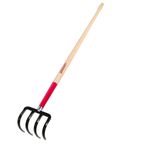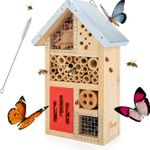Hi GPODers!
Carla Zambelli Mudry has been treating us to monthly updates on her marvelous garden in Malvern, Pennsylvania, from her earliest spring blooms (Carla’s Early Spring Flowers Part 1 and Part 2) to the fabulous flowers and foliage of the midseason (Carla’s Mid-Spring Flowers and Mid-Spring Foliage), and then the roses and clematis that mark May (Roses and Clematis Bloom in Carla’s Garden). Today she is back to share some spectacular scenes from a lush and colorful June, and one of those highlights is her incredible hydrangea collection. Carla’s hydrangeas are well-documented on Garden Photo of the Day (Hydrangea Season in Carla’s Garden; A Perfect Combination: Daylilies and Hydrangeas; Hydrangeas, Roses, and More), but she still manages to send new varieties and pairings to enjoy.
P.S.: If you’re looking to grow a hydrangea collection like Carla’s, or get your current plants to perform better, check out our new hydrangea growing guide: Hydrangea Project Guide
Greetings! It’s June and things are quite lush, including the weeds unfortunately, because we’ve had so much rain. So you just have to tackle things bit by bit. All of a sudden, the first flush of roses has given way to hydrangeas, and lilies are next! On the schedule for this coming week is feeding the roses again. Roses are heavy feeders, and you have to pay attention to that. Sadly, one of the things my arborist is tackling for us is trying to defend the beautiful beech trees in our woods from beech leaf wilt. It’s a real problem. How does your garden grow?
—Care Zambelli Mudry, Malvern, Pennsylvania
 While the variety you select will affect the shade or tint of your hydrangea blooms, your soil will have the greatest impact on the color flowers you’ll get. While most hydrangeas will have pink flowers when you purchase them from the nursery, acidic soil with aluminum will quickly turn those blooms blue when you plant them in the ground. This can be tricky for those striving for a particular color palette, but fantastic if you love those classic clusters of blue bigleaf hydrangea (Hydrangea macrophyllaZones 6–9) blooms. Learn more about hydrangea color here: How to Change Hydrangea Bloom Color.
While the variety you select will affect the shade or tint of your hydrangea blooms, your soil will have the greatest impact on the color flowers you’ll get. While most hydrangeas will have pink flowers when you purchase them from the nursery, acidic soil with aluminum will quickly turn those blooms blue when you plant them in the ground. This can be tricky for those striving for a particular color palette, but fantastic if you love those classic clusters of blue bigleaf hydrangea (Hydrangea macrophyllaZones 6–9) blooms. Learn more about hydrangea color here: How to Change Hydrangea Bloom Color.
 If you’re looking for something a little more predictable, there are some great options with no pigment. Here, Carla has a nice white variety paired with a hosta in the background and a stunning oakarof hydrangea (Hydrangea quartifoliaZones 5–9) in the foreground.
If you’re looking for something a little more predictable, there are some great options with no pigment. Here, Carla has a nice white variety paired with a hosta in the background and a stunning oakarof hydrangea (Hydrangea quartifoliaZones 5–9) in the foreground.
 A smaller hydrangea planted in a bed by Carla’s deck and patio has a sprinkling of small bloom clusters, but still stands out among a sea of lovely green foliage plants.
A smaller hydrangea planted in a bed by Carla’s deck and patio has a sprinkling of small bloom clusters, but still stands out among a sea of lovely green foliage plants.
 “Quite lush” might be an understatement, as Carla’s patio appears to be completely surrounded by vibrant and diverse greenery. A couple of banana trees add to the tropical rainforest feel.
“Quite lush” might be an understatement, as Carla’s patio appears to be completely surrounded by vibrant and diverse greenery. A couple of banana trees add to the tropical rainforest feel.
 Throughout all that green are amazing pops of dazzling color. Some Tie Dye clematis (Clematis ‘Tie Dye’, Zones 4–9) keep the tropical feel going.
Throughout all that green are amazing pops of dazzling color. Some Tie Dye clematis (Clematis ‘Tie Dye’, Zones 4–9) keep the tropical feel going.
 But it is the hydrangeas that continue to steal the spotlight in June! The mesmerizing purple-pink tones in this variety are glorious— potentially a Tuff Stuff™ mountain hydrangea (Hydrangea serat ‘MAK20’, Zones 5–9)?
But it is the hydrangeas that continue to steal the spotlight in June! The mesmerizing purple-pink tones in this variety are glorious— potentially a Tuff Stuff™ mountain hydrangea (Hydrangea serat ‘MAK20’, Zones 5–9)?
 I’ve always admired how Carla has crafted a garden that melds so well with its surroundings. Looking out from this vantage point, it’s hard to tell exactly where Carla’s garden ends and the forest begins.
I’ve always admired how Carla has crafted a garden that melds so well with its surroundings. Looking out from this vantage point, it’s hard to tell exactly where Carla’s garden ends and the forest begins.
 Carla’s containers were also thriving last month. Various herbs and annuals make for a colorful and fragrant display.
Carla’s containers were also thriving last month. Various herbs and annuals make for a colorful and fragrant display.
 Another hydrangea, this one with lovely light pink blooms, is complemented wonderfully by big fern fronds and a light green maple. Another great companion is Carla’s dog, which you can see is inspecting the hydrangea closely!
Another hydrangea, this one with lovely light pink blooms, is complemented wonderfully by big fern fronds and a light green maple. Another great companion is Carla’s dog, which you can see is inspecting the hydrangea closely!
 Quickly becoming a garden favorite, and for good reason, Eclipse® bigleaf hydrangea (Hydrangea macrophylla ‘Bailmacseven’, Zones 5–9) stands out from the crowd and makes a statement. As this is a newer cultivar, the specimens I’ve seen in gardens so far have been small. I cannot wait to see how these plants mature over the years.
Quickly becoming a garden favorite, and for good reason, Eclipse® bigleaf hydrangea (Hydrangea macrophylla ‘Bailmacseven’, Zones 5–9) stands out from the crowd and makes a statement. As this is a newer cultivar, the specimens I’ve seen in gardens so far have been small. I cannot wait to see how these plants mature over the years.
 While Carla’s landscape is dominated by huge trees that drench her garden in shade, there are spots where the sun makes all that lush foliage glow. In these spots, even more flowers create large swatches of color.
While Carla’s landscape is dominated by huge trees that drench her garden in shade, there are spots where the sun makes all that lush foliage glow. In these spots, even more flowers create large swatches of color.
Thank you so much for another fabulous update from your garden, Carla! No matter what time of year you share photos, there is always something exciting to enjoy, but hydrangea season is one of my favorites.
Are you a plant collector? Is your garden a gallery of the most enticing cultivars you can acquire? Let us know in the comments what plant you go gaga over, or consider sharing some of your favorite photos with the blog! Follow the directions below to submit photos via email, or send me a DM on Instagram: @agirlherdogandtheroad.
We want to see YOUR garden!
Have photos to share? We’d love to see your garden, a particular collection of plants you love, or a wonderful garden you had the chance to visit!
To submit, send 5–10 photos to (email protected) along with some information about the plants in the pictures and where you took the photos. We’d love to hear where you are located, how long you’ve been gardening, successes you are proud of, failures you learned from, hopes for the future, favorite plants, or funny stories from your garden.
Have a mobile phone? Tag your photos on Facebook, Instagram or Twitter with #FineGardening!
Do you receive the GPOD by email yet? Sign up here
Fine Gardening Recommended Products

Razor-Back Potato/Refuse Hook
Fine Gardening receives a commission for items purchased through links on this site, including Amazon Associates and other affiliate advertising programs.

Niteangel Natural Wooden Insect Hotel, Garden Insect House for Ladybugs, lacewings, Butterfly, Bee, Bug
Fine Gardening receives a commission for items purchased through links on this site, including Amazon Associates and other affiliate advertising programs.
The insect nest box provide a safe environment where garden creatures can shelter, hibernate and lay their eggs, the insect house can also keep insects from entering your warm room. The insect hotel makes it easy to find and observe fascinating creatures. the butterfly, bees and ladybugs can use this product as habitat. Dry wood and Bamboo can be home to many insects such as ladybirds and lacewings which eat aphids and help keep your plants pest-free. the insect hotel improve the growth of plants in your yard by attracting beneficial insects. The iron design on the top can keep the insect house from rainwater. Let the insect house have a longer useful life and make the insects more comfortable. If you only have a balcony or yard, the hanging garden shelter is ideal as it provides a choice of suitable habitats in a small area.

